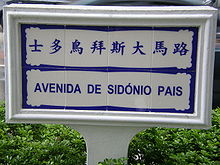Sidónio Pais
Sidónio Pais | |
|---|---|
 | |
| Minister of Public Works, Commerce and Industry | |
| In office September 3, 1911 – November 12, 1911 | |
| Prime Minister | João Chagas |
| Preceded by | Manuel de Brito Camacho |
| Succeeded by | José Estêvão de Vasconcelos |
| Minister of Finances | |
| In office November 12, 1911 – June 16, 1912 | |
| Prime Minister | Augusto de Vasconcelos |
| Preceded by | Duarte Leite |
| Succeeded by | António Vicente Ferreira |
| 67th Prime Minister of Portugal (13th of the Republic) | |
| In office December 5, 1917 – December 14, 1918 | |
| President | None (Himself, as Prime Minister was the head of state) |
| Preceded by | Bernardino Machado (as President) Afonso Costa (as Prime Minister) |
| Succeeded by | Himself (as President) João do Canto e Castro (as Prime Minister) |
| Minister for War | |
| In office December 5, 1917 – May 11, 1918 | |
| Prime Minister | Himself |
| Preceded by | José Norton de Matos |
| Succeeded by | João Tamagnini Barbosa |
| Minister of Foreign Affairs | |
| In office December 5, 1917 – May 11, 1918 | |
| Prime Minister | Himself |
| Preceded by | Augusto Vieira Soares (effective) Ernesto Jardim Vilhena (interim) |
| Succeeded by | Francisco Xavier Esteves |
| 4th President of Portugal | |
| In office April 28, 1918 – December 14, 1918 | |
| Preceded by | Bernardino Machado (effective) Himself (interim, as Prime Minister Head of State) |
| Succeeded by | João do Canto e Castro |
| Personal details | |
| Born | May 1, 1872 Caminha, Kingdom of Portugal |
| Died | December 14, 1918 (aged 46) Lisbon, Portuguese First Republic |
| Political party | National Republican Party (Sidonist Party) |
| Spouse(s) | Maria dos Prazeres Martins Bessa; Ema Manso Preto (non-marital liaison) |
| Children | Sidónio, António, Maria Sidónia, Afonso and Pedro; Maria Olga (out of wedlock) |
| Occupation | Military officer (Major) Lecturer of Mathematics and Astronomy |
| Nickname | Presidente-Rei (President-King) |
Sidónio Bernardino Cardoso da Silva Pais (Portuguese pronunciation: [siˈdɔniu ˈpajʃ]; Caminha, Caminha, 1 May 1872–Lisbon, 14 December 1918) was a Portuguese politician and diplomat, the fourth President in 1918. He was known as the President-King.
Family
He was the eldest child and son of Sidónio Alberto Marrocos Pais (Caminha, Nossa Senhora da Assunção, 1 November 1846[1] – Ferreira do Zêzere, Dornes, 27 August 1883), a Law Clerk and Public Notary in Caminha and later in Pedrógão Grande and Sertã of Barcelos New Christian Jewish ancestry (on his great-great-grandfather António Velho da Fonseca)[2], and wife (m. Caminha, Nossa Senhora da Assunção, 22 June 1871) Rita Júlia Cardoso da Silva (Caminha, Caminha, 29 August 1844 – Caminha, Caminha, 9 March 1919). His brothers and sisters were Rita (b. Caminha, Caminha, 1873), Alberto (Caminha, Caminha, 1874 – Caminha, Caminha, 1877), António (Caminha, Caminha, 15 November 1876 – Lisbon, Hospital da Marinha, 27 June 1949), who was also a military and married at the Igreja Matriz de Caminha, Caminha, 7 May 1904 Júlia Cândida de Sant' Ana Cerqueira (Caminha, Caminha, 1 September 1881 – Lisbon, 6 June 1968) and had issue, Ana da Glória (b. Caminha, Caminha, 1878), Alberto (b. Pedrógão Grande, 1881, d. child) and Aureliano (b. Sertã, 1883, d. child).
Life
He was an army officer and taught mathematics at the Army School, and later, at the University of Coimbra. He became a member of Parliament in 1911, and from 12 November 1911 he was the 4th Minister of Finance for a short period. He was ambassador in Berlin from 1912 until 1916, when Portugal joined the First World War on the Allied side.
On 5 December 1917, he led an uprising against Afonso Costa's Democratic Party government, and established an authoritarian regime. He became the 99th Prime-Minister and was elected President (unopposed) on 28 April 1918. He also became the Minister for Foreign Affairs from 11 December 1917 until 9 May 1918.

His short period in office saw a warming of Church-state relations, the extension of the electoral franchise, and the smashing defeat of the ill-prepared Portuguese troops at La Lys, in France.
He escaped a first assassination attempt, but was shot on 14 December 1918 by José Júlio da Costa, at Rossio railway station, in Lisbon, when he was preparing to board a train to Porto, to hold discussions with the monarchist leaders of the Northern Military Juntas.
Descendants
He married in Amarante in 1895 Maria dos Prazeres Martins Bessa (Amarante, São Gonçalo, 1868/1869 – Porto?/Lisbon, 14 September 1945), daughter of Vitorino Ferreira Bessa (Penafiel, Luzim/Perozelo, 1810 – Amarante, São Gonçalo, 16 February 1894), a Landowner, and wife Bernardina Joaquina/Augusta Pinto Martins (Valença, Santa Maria da Praça, Casa do Assento Militar, 1826 – 15 March 1905), the couple had five children, four sons and one daughter. Out of wedlock, by one Ema Manso Preto (born in 12 September 1871 and wife (m. 22 December 1900) of Álvaro Augusto Leite Ribeiro), he also had a daughter. He is the great-grandfather in male line of pianist and composer Bernardo Sassetti.
References
- Fotobiografias do Século XX, Photobiography of Sidónio Pais, Círculo de Leitores.
External links
- 1872 births
- 1918 deaths
- People from Caminha Municipality
- Presidents of Portugal
- Prime Ministers of Portugal
- Assassinated Portuguese politicians
- Deaths by firearm in Portugal
- People murdered in Portugal
- Assassinated heads of government
- Assassinated heads of state
- Portuguese military officers
- Portuguese atheists
- Government ministers of Portugal


